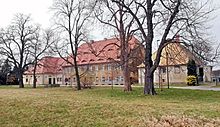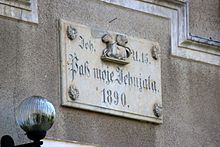Nostitz (Weißenberg)
|
Nostitz
Nosaćicy City of Weißenberg
Coordinates: 51 ° 9 ′ 55 ″ N , 14 ° 40 ′ 35 ″ E
|
|
|---|---|
| Height : | 205–225 m above sea level NN |
| Residents : | 174 (December 31, 2016) |
| Incorporation : | March 1, 1994 |
| Postal code : | 02627 |
| Area code : | 035876 |
|
The new manor in Nostitz in 1859
|
|
Nostitz , in Sorbian , is a village with 207 inhabitants in the Bautzen district in Saxony and part of the city of Weißenberg . It belongs to the official Sorbian settlement area in Saxony.
location
Nostitz is located on the left side of the Löbauer Water between Löbau and Weißenberg, 5 km south of the latter city. In the southeast it borders on Trauschwitz, in the northwest lies the 264 m high Strohmberg and in the west the 237 m high Monumentsbusch.
history
The first written mention of Nostitz comes from the year 1280, the origin of the village is Sorbian . At that time, the place was the seat of power of the Lusatian noble family von Nostitz , who, however, gave up their ancestral seat at Kittlitz Castle as early as 1439. The tine ( Nossotez ) in the coat of arms of the Nostitzers indicates their origin. The von Baudissin on Niederkaina bought the manor from the von Nostitz family . From their successors, those of Bellwitz, the property passed in 1541 to the Lausitz line of those of Gersdorff , who held it until 1638.
Nostitz had always been parish in Kittlitz and there was a small pilgrimage chapel in the village, which was consecrated to Saint Veronica. After the Reformation, the lords of Gersdorff raised the chapel to a parish church in 1587, but the pastor Georgius left the place as early as 1594 because the small community could not support him.
80 years later, Joachim Ernst von Ziegler and Klipphausen had the chapel replaced with a church building, which was consecrated as a parish church on June 24, 1679 and whose parish also included the villages of Grube, Krappe, Spittel and Trauschwitz. The von Ziegler and Klipphausen owned Nostitz from 1646 to 1720. In the 16th and 17th centuries, the castle was converted into a castle, which was completed in 1688. Owners from the Oberlausitz line (Gröditz line) of the Ziegler and Klipphausen were among others Joachim Johann (1592-1630), Wolf Rudolf (1622-1685) and Karl Gottlob (1650-1715). The latter was lord of Obercunewalde and Nostitz and from 1705 until his death on July 14, 1715, he was in command of the Königstein fortress .
In the 18th century the manor Nostitz was awarded to Johann Adolph Schmeiß von Ehrenpreiß (Ehrenpreisberg). Thereafter, Johann Christian Edler von Lossa (1692–1754), born in Zittau , was the landlord. He was a chamber and mountain ridge, traveled to Freiberg several times a year , often stayed in Dresden and had a chemical laboratory under the tower in the Ebersbach castle courtyard (now part of Schöpstal ), and according to another source also in the Nostitz castle tower. Von Lossa died in Freiberg and was buried in the Petrikirche there. In his will he considered churches and the poor in Nostitz, Ebersbach and Zittau, as well as invalid and poor miners in Freiberg.
Gottlieb Wilhelm von Bressler, who received the Lauske estate (Weißenberg) and expanded it into his seat, inherited the Nostitz estate from his aunt in 1777. At that time only 8 gardeners and 3 cottagers lived in the village. In 1791 peasant unrest broke out in Nostitz and Trauschwitz. In 1812 Johanna Wilhelmine Gottliebe von Bressler bought the castle from her father. During the Napoleonic Wars, the French troops marched through Nostitz on September 10, 1813 and set fire to the place the next day. The castle and five farms burned down. In Trauschwitz, too, 15 houses including the rectory were infected. Gottlieb Wilhelm von Bressler, who had meanwhile been promoted to the Saxon Secret Council, died on December 9, 1814 in Lauske and was buried in Nostitz on December 17.
After the end of the war, a new manor was built on the edge of the village in the Masonic sense as an octagonal terrain with a manor house and farm buildings. The manor was surrounded by a park. From 1823 the estate belonged to the Counts of Reichenbach-Goschütz . From 1857 onwards, the property was transferred to a family foundation that went to Hans Wilhelm Carl von Bressler.
In 1866, the church was rebuilt and expanded for the intended parish of Maltitz, but this did not take place. The residents of Nostitz, which belonged to the administrative authority of Löbau , were mainly farmers who cultivate the fertile fields in the area. In 1869 Spittel was incorporated and in 1871 Nostitz had 123 inhabitants.
In 1945 the last landowner named Krause, who had acquired the land in 1930, was expropriated. After the Second World War, numerous new farms were established on the estate and displaced persons from Silesia were settled. As a result, the number of inhabitants increased significantly from 263 (1939) to 516 (1946).
The manor was initially used as a machine rental station , then as a machine-tractor station , repair tractor station , from which a district operation for agricultural technology emerged. The municipal office also moved into the formerly stately home. After 1950 LPGs were founded and the farmers collectivized. A dairy cattle plant was built in Trauschwitz and a tobacco drying plant was also built there.
In 1952, the municipality Nostitz was the district Löbau in the district Bautzen reclassified. In 1979 renovation work was carried out on the church, with work on the tower in 1992 the renovation of the building was completed.
After the political change, the road maintenance depot Nostitz was located on the estate and the VLE-Verkehrsleiteinrichtung GmbH is also based there. The municipality of Nostitz, which had belonged to the Weißenberg administrative community since 1991, was incorporated into the city of Weißenberg in 1994 . At the time of incorporation there were 348 inhabitants in Nostitz with its three districts.
Population and language
For his statistics on the Sorbian population in Upper Lusatia, Arnošt Muka determined a population of 107 in the 1880s, including 70 Sorbs (65%) and 37 Germans. At that time, Nostitz was already at the very edge of the Sorbian language area. In 1956 Ernst Tschernik counted a Sorbian-speaking population of only 12.8%. Today the language has largely disappeared from everyday local life, but there are still some Sorbian traces, such as a baptismal bowl, a donation box and a flag with Sorbian inscription in the church, at least two bilingual gravestones in the old cemetery and a monolingual Sorbian inscription on the old one Village school in the Trauschwitz district.
In 1991 the register of the State Statistical Office of the Free State of Saxony showed a population of 342.
Local division
The locations of Grube ( Jama ), Spittel ( Špikały ) and Trauschwitz ( Trušecy ) belong to Nostitz . However, the former are counted as separate districts by the city of Weißenberg.
Attractions
- Church, consecrated in 1679, expanded in 1866 with the crypt of the von Bressler family and the fortress commander of the Königstein Karl Gottlob von Ziegler and Klipphausen (1650–1715).
- the Luther oak planted in 1883 with Luther stone next to the church
- Castle ruin
- Rittergut Nostitz was built after 1813 and has barrel and cross vaults.
- Monuments bush with a monument made of Pirna sandstone by the landowner Graf von Bressler
- Stork's nest on the forge of the former Trauschwitz tobacco drying plant
Personalities
- Adam Gottlob Schirach (1724–1773), theologian, beekeeper and author
- Gustav Reinhold Richter (1817–1903), member of the Reichstag and member of the Hamburg parliament
literature
- Cornelius Gurlitt : Nostitz. In: Descriptive representation of the older architectural and art monuments of the Kingdom of Saxony. 34. Issue: Official Authority Löbau . CC Meinhold, Dresden 1910, p. 447.
Individual evidence
- ↑ Information about the city of Weißenberg; As of December 31, 2008
- ↑ Anonymos (1837): Remembering Joh. Christian Edlen v. Lossa. Neues Lausitzisches Magazin Vol 15 (NF 2), pages 287–291. Digitized
- ↑ s: Manors and castles in the kingdom of Saxony: Nostitz
- ^ The Counts of Breßler on Lauske 1775–1932 at www.lauske.de (accessed on January 1, 2016)
- ↑ a b Portal historical Saxony (accessed on January 2, 2016)
- ↑ a b Werner Schmidt (Hrsgb.): Between Löbau and Herrnhut: Results of the regional study in the area of Löbau and Reichenbach / OL. (Values of the German homeland, vol. 56). Weimar: Hermann Böhlaus successor, 1996. ISBN 3-7400-0935-7 , pages 57-59.
- ↑ Ernst Tschernik: The development of the Sorbian population . Akademie-Verlag, Berlin 1954.
- ^ Ludwig Elle: Language policy in the Lausitz . Domowina-Verlag, Bautzen 1995, p. 245 .
- ↑ Adam Gottlob Schirach: The re-invented Oberlausitz bees multiplication linked with nature and art, or making young swarms of bees in living rooms at the beginning of May: Along with other useful and edifying comments from bees. Richter, Bautzen 1761 URN
Web links
- Nostitz in the Digital Historical Directory of Saxony
- Portrait of Karl Gottlob von Ziegler and Klipphausen (1650–1715) in the Deutsche Fotothek
- http://www.loebaufoto.de/nostitz.htm







